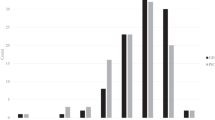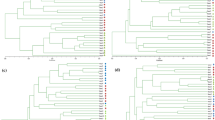Abstract
Background
As waxy maize is considered a key economic crop in Korea, an understanding of its genetic variation and differentiation is fundamental for the selective plant breeding. The maize genome is primarily composed of transposable elements, for which large and stable insertions generate variations that reflect selection during evolution.
Objectives
This study was to elucidate the genetic diversity based on the contribution of TEs and to investigate the effect of Mu transposition on the genetic divergence of waxy and common maize. We also performed an association analysis on these inbred lines to determine the Mu insertions associated with agronomic traits.
Methods
In this study, we utilized a Mutator-based transposon display method to study the genetic diversity and population structure of 40 waxy and 40 common inbred lines of maize in the Gangwon Agricultural Research and Extension Services collection at the Maize Research Institute.
Results
We detected polymorphisms in 86.33% of 278 Mutator (Mu) anchored loci, reflecting the activity of the Mu element and its contribution to genetic variation. Common maize showed a substantial amount of genetic diversity, which was greater than that observed in waxy maize. Principal-coordinate and neighbor-joining cluster analyzes consistently supported the presence of two genetically distinct groups. However, the distribution of genetic variation within the populations was much higher than the genetic differentiation among the populations. To explore the contribution of the Mu element to phenotypic variation, we analyzed the associations with ten important agronomical traits. On the basis of the combined results from two models (QGLM and Q + KLM), we found significant associations between seven Mu loci and four different traits.
Conclusions
These results will assist waxy maize breeders in choosing parental lines and be useful for marker-assisted selection.


Similar content being viewed by others
References
Barkan A, Martienssen RA (1991) Inactivation of maize transposon Mu suppresses a mutant phenotype by activating an outward-reading promoter near the end of Mu1 . Proc Natl Acad Sci USA 88:3502–3506
Bradbury PJ, Zhang Z, Kroon DE, Casstevens TM, Ramdoss Y, Buckler ES (2007) TASSEL: software for association mapping of complex traits in diverse samples. Bioinformatics 23:2633–2635. https://doi.org/10.1093/bioinformatics/btm308
Branco CJ et al (2007) IRAP and REMAP assessments of genetic similarity in rice. J Appl Genet 48:107–113. doi:https://doi.org/10.1007/BF03194667
Brunner S, Fengler K, Morgante M, Tingey S, Rafalski A (2005) Evolution of DNA sequence nonhomologies among maize inbreds. Plant Cell 17:343–360. doi:https://doi.org/10.1105/tpc.104.025627
Castelletti S, Tuberosa R, Pindo M, Salvi S (2014) A MITE transposon insertion is associated with differential methylation at the maize flowering time QTL Vgt1. G3 4:805–812. https://doi.org/10.1534/g3.114.010686
Diao XM, Lisch D (2006) Mutator transposon in maize and MULEs in the plant genome Acta. Acta Genet Sinica 33:477–487. https://doi.org/10.1016/S0379-4172(06)60075-9
Du C, Fefelova N, Caronna J, He L, Dooner HK (2009) The polychromatic Helitron landscape of the maize genome. Proc Natl Acad Sci USA 106:19916–19921. doi:https://doi.org/10.1073/pnas.0904742106
Sanseverino W et al (2015) Transposon insertions, structural variations, and SNPs contribute to the evolution of the melon genome. Mol Biol Evol 32:2760–2774. https://doi.org/10.1093/molbev/msv152
Excoffier L, Lischer HE (2010) Arlequin suite ver 3.5: a new series of programs to perform population genetics analyses under Linux and Windows. Mol Ecol Resour 10:564–567. doi:https://doi.org/10.1111/j.1755-0998.2010.02847.x
Fan L et al (2008) Molecular evidence for post-domestication selection in the Waxy gene of Chinese waxy maize. Mol Breed 22:329–338. https://doi.org/10.1007/s11032-008-9178-2
Fan L et al (2009) Post-domestication selection in the maize starch pathway. PLoS One 4:e7612. doi:https://doi.org/10.1371/journal.pone.0007612
Girard L, Freeling M (2000) Mutator-suppressible alleles of rough sheath1 and liguleless3 in maize reveal multiple mechanisms for suppression. Genetics 154:437–446
Hao D et al (2015) Identification of Genetic Differentiation between Waxy and Common Maize by SNP. Genotyping PLoS One 10:e0142585. doi:https://doi.org/10.1371/journal.pone.0142585
Hardy OJ, Vekemans X (2002) Spagedi: a versatile computer program to analyse spatial genetic structure at the individual or population levels. Mol Ecol Notes 2:618–620. doi:https://doi.org/10.1046/j.1471-8286.2002.00305.x
Holsinger K, Lewis P (2003) HICKORY: a package for analysis of population genetic data V1.0, University of Connecticut
Huang X, Lu G, Zhao Q, Liu X, Han B (2008) Genome-wide analysis of transposon insertion polymorphisms reveals intraspecific variation in cultivated rice. Plant Physiol 148:25–40. doi:https://doi.org/10.1104/pp.108.121491
Huang CR, Burns KH, Boeke JD (2012) Active transposition in genomes. Annu Rev Genet 46:651–675. doi:https://doi.org/10.1146/annurev-genet-110711-155616
Jaccard P (1908) Nouvelles researches sur la distribution florale. Bull Soc Vaud Sci Nat 44:223–270
Kindt R, Coe R (2005) Tree diversity analysis. A manual and software for some common statistical methods for biodiversity and ecological analysis Nairobi, Kenya, World Agroforestry Centre (ICRAF)
Klosgen RB, Gierl A, Schwarz-Sommer Z, Saedler H (1986) Molecular analysis of the waxy locus of Zea mays. MGG Mol Gen Genet 203:237–244. https://doi.org/10.1007/bf00333960
Korswagen HC, Durbin RM, Smits MT, Plasterk RHA (1996) Transposon Tc1-derived, sequence-tagged sites in Caenorhabditis elegans as markers for gene mapping. Proc Natl Acad Sci USA 93:14680–14685. https://doi.org/10.1073/pnas.93.25.14680
Lee EA, Tracy WF (2009) Modern maize breeding. In: Bennetzen JL, Hake S (eds) Handbook of maize: genetics and genomics. Springer New York, New York, pp 141–160. https://doi.org/10.1007/978-0-387-77863-1_7
Lee JK, Kwon SJ, Park KC, Kim NS (2005) Isaac-CACTA transposons: new genetic markers in maize and sorghum. Genome 48:455–460. https://doi.org/10.1139/g05-013
Lisch D (2002) Mutator transposons trends in plant. Science 7:498–504
Liu K, Goodman M, Muse S, Smith JS, Buckler E, Doebley J (2003) Genetic structure and diversity among maize inbred lines as inferred from DNA microsatellites. Genetics 165:2117–2128
Liu Y, Hou X, Zhang J, Zu W, Huang Y (2016) The formation of maize foundation inbred lines: analysis in different perspective. Int J Environ Agric Res 2
Lowe B, Mathern J, Hake S (1992) Active Mutator elements suppress the knotted phenotype and increase recombination at the Kn1-O tandem duplication. Genetics 132:813–822
Makarevitch I, Waters AJ, West PT, Stitzer M, Hirsch CN, Ross-Ibarra J, Springer NM (2015) Transposable elements contribute to activation of maize genes in response to abiotic stress. PLoS Genet 11:e1004915. https://doi.org/10.1371/journal.pgen.1004915
Manninen O, Kalendar R, Robinson J, Schulman AH (2000) Application of BARE-1 retrotransposon markers to the mapping of a major resistance gene for net blotch in barley. Mol Gen Genet 264:325–334. doi:https://doi.org/10.1007/s004380000326
Morgante M, De Paoli E, Radovic S (2007) Transposable elements and the plant pan-genomes . Curr Opin Plant Biol 10:149–155. https://doi.org/10.1016/j.pbi.2007.02.001
Ohtsu K, Hirano HY, Tsutsumi N, Hirai A, Nakazono M (2005) Anaconda, a new class of transposon belonging to the Mu superfamily, has diversified by acquiring host genes during rice evolution. Mol Genet Genomics 274:606–615. doi:https://doi.org/10.1007/s00438-005-0053-0
Park KC, Kim NH, Cho YS, Kang KH, Lee JK, Kim NS (2003) Genetic variations of AA genome Oryza species measured by MITE-AFLP. Theor Appl Genet 107:203–209. doi:https://doi.org/10.1007/s00122-003-1252-x
Park KJ, Sa KJ, Koh HJ, Lee JK (2013) QTL analysis for eating quality-related traits in an F2:3 population derived from waxy corn x sweet corn cross. Breed Sci 63:325–332. doi:https://doi.org/10.1270/jsbbs.63.325
Perrier X, Jacquemoud-Collet J (2006) DARwin software: Dissimilarity analysis and representation for windows Website http://darwin.cirad.fr/darwin
Prasanna BM, Pixley K, Warburton ML, Xie C-X (2010) Molecular marker-assisted breeding options for maize improvement in Asia . Mol Breed 26:339–356. https://doi.org/10.1007/s11032-009-9387-3
Pritchard JK, Stephens M, Donnelly P (2000) Inference of population structure using multilocus genotype data. Genetics 155:945–959
Queen RA, Gribbon BM, James C, Jack P, Flavell AJ (2004) Retrotransposon-based molecular markers for linkage and genetic diversity analysis in wheat. Mol Genet Genom 271:91–97. https://doi.org/10.1007/s00438-003-0960-x
Ramekar RV, Park KC, Sa KJ, Lee JK (2018) Mutator-based transposon display: a genetic tool for evolutionary and crop-improvement studies in maize. Mol Biotechnol 60:799–809. https://doi.org/10.1007/s12033-018-0118-z
Rodriguez M, O’Sullivan D, Donini P, Papa R, Chiapparino E, Leigh F, Attene G (2006) Integration of retrotransposons-based markers in a linkage map of Barley. Mol Breed 17:173–184. https://doi.org/10.1007/s11032-005-4885-4
Sa KJ, Park JY, Woo SY, Ramekar RV, Jang C-S, Lee JK (2014) Mapping of QTL traits in corn using a RIL population derived from a cross of dent corn × waxy corn. Genes Genom 37:1–14. https://doi.org/10.1007/s13258-014-0223-8
Sa KJ, Park JY, Choi SH, Kim BW, Park KJ, Lee JK (2015) Genetic diversity, population structure, and association mapping of agronomic traits in waxy and normal maize inbred lines. Genet Mol Res 14:7502–7518. doi:https://doi.org/10.4238/2015.July.3.26
Schluter PM, Harris SA (2006) Analysis of multilocus fingerprinting data sets containing missing data. Mol Ecol Notes 6:569–572. https://doi.org/10.1111/j.1471-8286.2006.01225.x
Schnable PS et al (2009) The B73 maize genome: complexity, diversity and dynamics. Science 326:1112–1115. https://doi.org/10.1126/science.1178534
Settles AM, Baron A, Barkan A, Martienssen RA (2001) Duplication and suppression of chloroplast protein translocation genes in maize. Genetics 157:349–360
Springer NM, Stupar RM (2007) Allelic variation and heterosis in maize: how do two halves make more than a whole? Genome Res 17:264–275. https://doi.org/10.1101/gr.5347007
Studer A, Zhao Q, Ross-Ibarra J, Doebley J (2011) Identification of a functional transposon insertion in the maize domestication gene tb1. Nat Genet 43:1160–1163. doi:https://doi.org/10.1038/ng.942
Tenaillon MI, Hufford MB, Gaut BS, Ross-Ibarra J (2011) Genome size and transposable element content as determined by high-throughput sequencing in maize and Zea luxurians. Genome Biol Evol 3:219–229. https://doi.org/10.1093/gbe/evr008
Tian M, Tan G, Liu Y, Rong T, Huang Y (2009) Origin and evolution of Chinese waxy maize: evidence from the Globulin-1 gene . Genet Resour Crop Evolut 56:247–255. https://doi.org/10.1007/s10722-008-9360-8
Troyer AF (2004) Background of US Hybrid Corn II. Crop Sci. https://doi.org/10.2135/cropsci2004.3700
Vitte C, Ishii T, Lamy F, Brar D, Panaud O (2004) Genomic paleontology provides evidence for two distinct origins of Asian rice (Oryza sativa L.). Mol Genet Genom 272:504–511. https://doi.org/10.1007/s00438-004-1069-6
Wu Y et al (2016) Molecular characterization of CIMMYT maize inbred lines with genotyping-by-sequencing SNPs. Theor Appl Genet 129:753–765. doi:https://doi.org/10.1007/s00122-016-2664-8
Yaakov B, Ceylan E, Domb K, Kashkush K (2012) Marker utility of miniature inverted-repeat transposable elements for wheat biodiversity and evolution. Theor Appl Genet 124:1365–1373. doi:https://doi.org/10.1007/s00122-012-1793-y
Yang Q et al (2013) CACTA-like transposable element in ZmCCT attenuated photoperiod sensitivity and accelerated the postdomestication spread of maize. Proc Natl Acad Sci USA 110:16969–16974. doi:https://doi.org/10.1073/pnas.1310949110
Yasuda K et al (2013) Utilization of transposable element mPing as a novel genetic tool for modification of the stress response in rice. Mol Breed 32:505–516. https://doi.org/10.1007/s11032-013-9885-1
Yeh FC, Yang RC, Boyle TB, Ye Z, Mao JX (1997) POPGENE, the user-friendly shareware for population genetic analysis molecular biology and biotechnology centre. University of Alberta, Canada
Zerjal T et al (2012) Maize genetic diversity and association mapping using transposable element insertion polymorphisms. Theor Appl Genet 124:1521–1537. doi:https://doi.org/10.1007/s00122-012-1807-9
Zheng H et al (2013) Genetic diversity and molecular evolution of Chinese waxy maize germplasm. PLoS One 8:e66606. doi:https://doi.org/10.1371/journal.pone.0066606
Zhong W-j, Zhang M-d, Yang L-q, Wang M-c, Zheng Y-l, Yang W-p, Gao Y-j (2012) Isolating the mutator transposable element insertional mutant gene mio16 of maize using double selected amplification of insertion flanking fragments (DSAIFF). J Integr Agric 11:1592–1600. https://doi.org/10.1016/S2095-3119(12)60162-2
Acknowledgements
This study was supported by the Cooperative Research Program for Agriculture Science and Technology Development (Project Nos. PJ01315701 and PJ013157), Rural Development Administration (RDA), and Golden Seed Project (213009-05-3-WT812/PJ01265002201901) of iPET (Korea Institute of Planning and Evaluation for Technology in Food, Agriculture, Forestry and Fisheries) based on the fund of RDA, Republic of Korea.
Author information
Authors and Affiliations
Corresponding author
Ethics declarations
Conflict of interest
The author declares that they have no conflict of interest.
Ethical approval
This article does not contain any studies with human subjects or animals performed by any of the above authors.
Additional information
Publisher's Note
Springer Nature remains neutral with regard to jurisdictional claims in published maps and institutional affiliations.
Electronic Supplementary Material
Below is the link to the electronic supplementary material.
Rights and permissions
About this article
Cite this article
Ramekar, R.V., Sa, K.J., Park, KC. et al. Genetic differentiation of Mutator insertion polymorphisms and association with agronomic traits in waxy and common maize. Genes Genom 42, 631–638 (2020). https://doi.org/10.1007/s13258-020-00928-6
Received:
Accepted:
Published:
Issue Date:
DOI: https://doi.org/10.1007/s13258-020-00928-6




